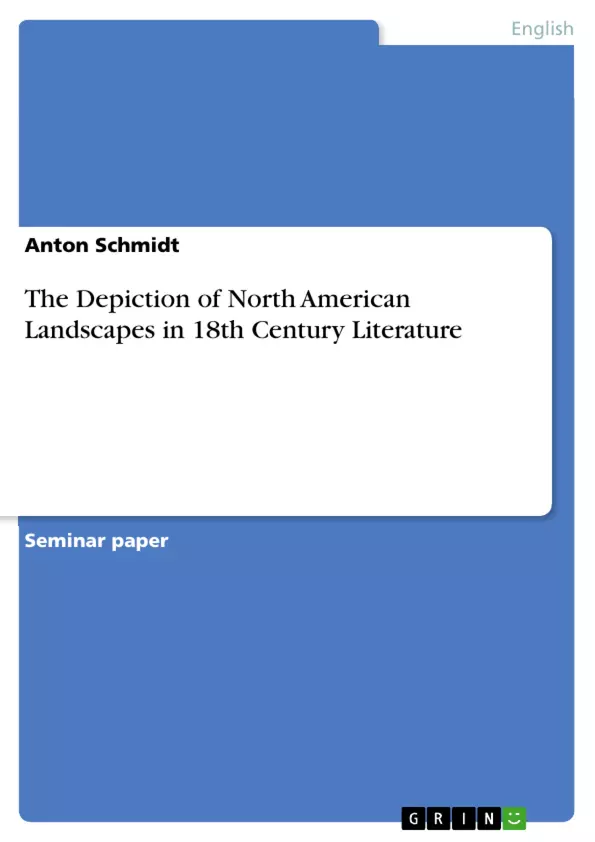This paper will analyse the perception of North American nature and its landscapes of eighteenth-century writers, explorers, and politicians in three different genres, such as poetry, notes, and travel logs. It will deal with the impressions by Count Buffon from "La Histiore Naturele", Thomas Jefferson’s discoveries in "Notes on the State of Virginia" and Richard Lewis’ self-identification and satire in "A Journey from Patapsco to Annapolis".
The first part of this research paper will explain different theories which are necessary for the analysis of these works. The paper will begin with the creation of meaning which landscapes have in literature. Then it will continue with the theory of landscapes as cultural phenomena which capture human history in their every layer of development with the arrival of a new era. Especially important is the identification of humanity as an inherent part of this construct. Furthermore, the paper will explain the traditional pastoral ideology – a concept which most migrants from the Old World knew from their countries of origins and believed that it would benefit their economic growth and social virtue. American pastoral as an innovation of the New World colonies is essential for this research, as it aims at taming the seemingly virgin landscapes of Americas.
Further, it is important to examine Humboldt’s definition of landscapes as types of space and the role he assigns to humankind in their formation, recreation, and development. Humboldt paid attention to both nature and man perceiving nature as a whole, and humanity as a part of nature, meaning that there is no human free landscape. In addition to that, this paper will present the Eurocentric approach to the natural habitat in the colonies explained by Marie L. Pratt, which works well with the pastoral ideology, and Stilgoe’s theory about the creation of landscapes which necessarily involves human initiative. This theory, to some extent, overlaps with Humboldt’s understanding of landscapes.
This paper will examine the concept of landscape in these three above-mentioned works as a cultural construct, applying these theories. The conclusions will be drawn based on differences and similarities of the respective observation of each chosen author. The question that is to be answered in my thesis is, how authors of travel literature in the eighteenth century perceived and interpreted North American landscapes.
Inhaltsverzeichnis (Table of Contents)
- Introduction
- Landscape as a Cultural Construct
- Landscapes and Literature
- Cultural Landscapes
- Pastoral Landscapes
- Landscapes in Traditional Pastoral Ideology
- American Pastoral
- Alexander von Humboldt's Landscapes
- M. L. Pratt and J. R. Stilgoe
- Pratt - The Imperial Eye
- Stilgoe Shaped Land
- Landscapes in Literature of the Eighteenth Century
- Count Buffon
- Thomas Jefferson's Notes on the State of Virginia
- Richard Lewis - A Journey from Patapsco to Annapolis
- Conclusion
Zielsetzung und Themenschwerpunkte (Objectives and Key Themes)
This research paper explores the perception of North American nature and its landscapes by eighteenth-century writers, explorers, and politicians. It analyzes the impressions of various figures, including Count Buffon, Thomas Jefferson, and Richard Lewis, across different genres like poetry, notes, and travel logs. The paper aims to examine how these individuals interpreted and perceived North American landscapes, drawing on various theoretical frameworks related to cultural constructs, pastoral ideology, and the influence of European perspectives on colonial landscapes.
- The formation and interpretation of landscapes as cultural constructs.
- The role of pastoral ideology and its influence on the perception of North American landscapes.
- The impact of European perspectives, such as those of Alexander von Humboldt, on the understanding of colonial landscapes.
- The diverse representations of North American landscapes in eighteenth-century travel literature.
- The relationship between landscape and identity, as demonstrated in the works of the selected authors.
Zusammenfassung der Kapitel (Chapter Summaries)
- Introduction: This chapter introduces the concept of travel literature in the seventeenth and eighteenth centuries, highlighting its diverse forms and the evolving interpretations of landscapes. It establishes the focus of the research paper, which is the analysis of eighteenth-century North American landscapes through the lens of different writers and their perspectives.
- Landscape as a Cultural Construct: This chapter delves into the creation of meaning associated with landscapes in literature, exploring the concept of landscapes as cultural phenomena that reflect human history and interaction with nature. It introduces key theorists like Bending and Lawson-Peebles, emphasizing the role of ideology and perspective in shaping the understanding of landscapes.
- Landscapes and Literature: This section examines the multifaceted nature of landscapes, highlighting their non-physical aspects and the influence of individual and cultural factors on their interpretation. It explores the use of landscapes in literature as tools for self-representation and the construction of meaning for the reader.
- Cultural Landscapes: This section delves into the diverse meanings and applications of the term "cultural landscape." It analyzes how landscapes reflect social and natural interactions, emphasizing the importance of individual experiences and historical context in shaping our understanding of the environment.
- Pastoral Landscapes: This section explores the traditional pastoral ideology and its influence on the perception of landscapes. It examines the concept of "American Pastoral" as an adaptation of traditional pastoral ideology in the context of colonial America.
Schlüsselwörter (Keywords)
This paper focuses on the key themes of cultural landscapes, pastoral ideology, travel literature, eighteenth-century America, North American landscapes, and the representation of nature in literature. The research examines the interplay between European perspectives and colonial realities, analyzing the works of prominent figures like Count Buffon, Thomas Jefferson, and Richard Lewis to shed light on the evolving understanding of North American landscapes during the eighteenth century.
- Quote paper
- Anton Schmidt (Author), 2020, The Depiction of North American Landscapes in 18th Century Literature, Munich, GRIN Verlag, https://www.hausarbeiten.de/document/1324534


